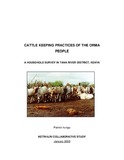| dc.description.abstract | Trypanosomosis, a disease mainly transmitted by tsetse flies, is widespread
throughout the humid and sub-humid areas of Africa. For centuries the disease
has taken its toll on cattle and people living in tsetse-infested areas. In Kenya,
25% of the country’s total landmass is tsetse infested. This land supports over
half of the country’s national cattle herd.
The Kenya Trypanosomiasis Research Institute (KETRI) has conducted a series
of studies over the last 20 years on the Orma Boran, an indigenous cattle breed
kept by the Orma tribe in Tana River district in the Coast province of Kenya.
Field studies on Galana Ranch, Coast province, Nguruman, Kajiado district, and
some laboratory based studies at their Nairobi headquarters have shown this
breed to be less susceptible to trypanosomosis than other Kenyan cattle. The
current study aimed to provide information on the Orma pastoralists and their
cattle in their own environment of the Tana River district.
A household survey was conducted in 12 locations of Tana River district. A total
of 48 household heads were interviewed and data collected on body weight for
407 cattle and milk yield for 164 cows. The household heads interviewed,
despite having minimal formal education, were very knowledgeable cattle
keepers. They selected their cattle for breeding or commercial purposes
primarily on the basis of their milk yield and body size. There was a marked
degree of sedentarisation amongst the Orma people in the areas studied. On
average, the household heads had resided in their current villages for 25 years.
The average herd size of these pastoralists was 156 head of cattle, some of
which remained close to the villages. The larger proportion of the cattle was
herded by young men away from the villages in fora herds and living in
temporary manyattas.
The mean live weight of mature cows was 250kg, mean calf weight at eight
months was 78kg. The average daily milk off-take was 1.6 litres per cow. The
mean yearly expenditure per household on trypanocidal drugs was Kshs 15,575,
but this varied greatly depending on the tsetse challenge in any particular area.
The Tana delta area, which is heavily infested by four species of tsetse fly, was
used by the majority of the households as dry season grazing for their cattle. | en |

